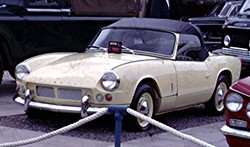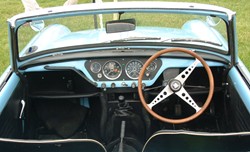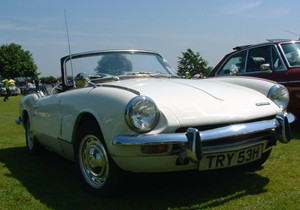Triumph Spitfire

Triumph launched the original Spitfire at the 1962 Motor Show. It was called the Triumph Spitfire 4. Four was the number of cylinders, not the model number. The Spitfire was an elegant, small sports car styled by Michellotti. Although aimed at the same market as the Austin-Healey Sprite, it looked more sophisticated and stylish. It had a larger, 1147cc, engine with more power than the Sprite's 1098cc. The first Spitfire was also slightly more expensive.
The Spitfire had door handles and locks on the outside and wind up windows, both luxuries for small sports cars of the time. The penalty was a more cramped cockpit. The hollow on the Sprite gave more elbow room.

The early Spitfire's cockpit was spartan. The floor was covered with rubber mats instead of carpet and the seats were thin. The Spitfire had a Mini-style centre instrument cluster. It still had full sports car instrumentation: a speedometer, rev counter, fuel and temperature gauges. The instruments would have been better directly in front of the driver, but the central arrangement may have made it easier to make left and right hand drive versions. The US market was the most important target for British sports cars.
The most controversial aspect of the Spitfire was the independent rear suspension. Motor magazine, testing an early car, found the handling safe and enjoyable. They did comment that when cornering at speed, the car's mild under-steer changed to controllable over-steer. The Spitfire's swing axle suspension caused the rear wheels to tuck in on sharp bends taken at speed. Motor also warned that long, fast curves needed to be approached with caution until the transition from under-steer to over-steer had taken place.
Motoring Which?, testing the same model, had different opinions. They claimed that the independent rear suspension could easily change the car's direction when cornering or driving straight on rough roads. On good roads the handling was reasonable. They thought ride in the Spitfire unsettling. It pitched diagonally on straight roads and was continuously restless on bumpy roads. Motor also concurred with this last comment when testing a Triumph Spitfire Mk3 head to head with an Austin-Healey Sprite and a Honda S800. Which?, in their test, had no hesitation in choosing the Austin-Healey Sprite as the better car of the two.
Triumph Spitfire Mk 2 - 1965 to 1967
Like the Sprite and Midget, the Spitfire was continuously improved throughout the sixties. The Mk 2 Spitfire was launched in March 1965. It had a slightly more powerful engine, 67bhp instead of 63bhp. Inside the car had improved trim, which was criticised in the Spitfire 4, and carpets on the floor. There was also a revised grille.
This version competed against the Sprite Mk III, which had an improved 1098cc engine, wind up windows and external door handles. It also had to compete against the much improved Sprite Mk IV which had the more powerful 1275cc engine and a proper folding hood.

Triumph Spitfire Mk 3
In 1966 the Spitfire became the Mk 3. This was the definitive 1960s' Spitfire. US regulations meant a change to the front of the car. Its raised bumper gave the Spitfire a different frontal appearance, known as the 'bone-in-the-mouth' grille. The Triumph Spitfire Mk 3 had a new 1296cc engine producing 75 bhp. It was now capable of speeds of nearly 100mph. Like the Sprite Mk IV, the Spitfire Mk 3 had a proper folding hood.

This picture, left, shows the neat dashboard of the Triumph Spitfire. It was common to the Mk 1 through to Mk 3, although the wood trim, a Triumph trademark, came in later in the 1960s.
It was a pity though that criticisms about the suspension were not addressed in this model. Spitfire fans had to wait for the Mk 4 model, introduced in October 1970, for this handling idiosyncrasy to be ironed out. Other Triumph models, the Vitesse and GT6 had been corrected earlier.
Motor tested the Mk3 car and were still reasonably happy with the handling. They warned that drivers needed to be prepared for a possible tail out moment if the car was pushed hard or if the driver had to take quick avoiding action. Motoring Which? also tested this car and were not as critical as they were of the earlier Spitfire 4. This time they found it hard to chose between the Sprite and the Spitfire.
Triumph Spitfire Mk 4 and 1500
The Spitfire moved into the seventies with a complete makeover. It had a restyled tail which was the beginning of a new look for Triumph. In 1974, the Spitfire gained a 1500cc engine, also fitted to the now in-house rival, the MG Midget. This final version of the Spitfire was produced until 1980.
More on the Triumph Spitfire
There are two main clubs catering for all Triumph models including Spitfires. See


Comments